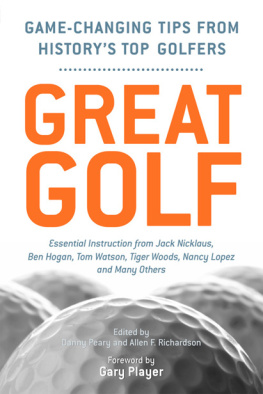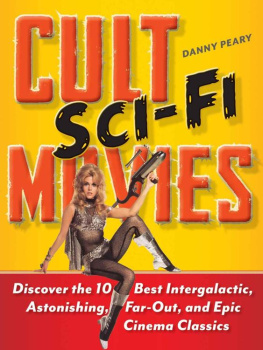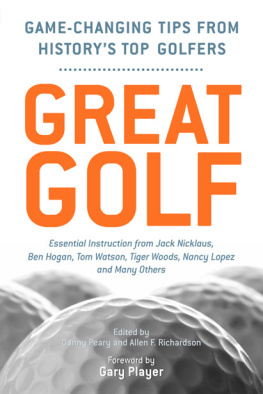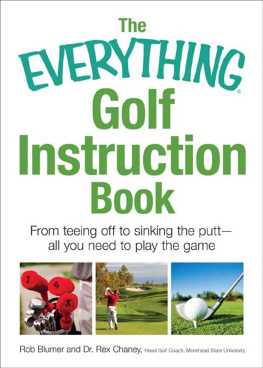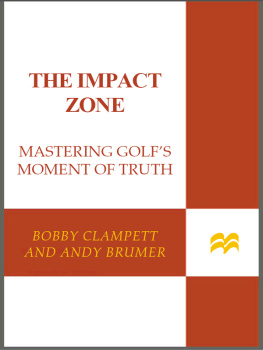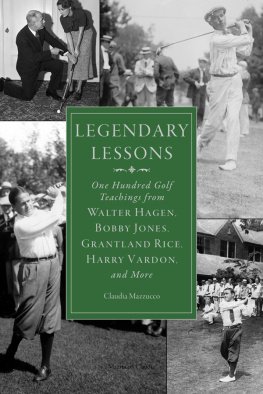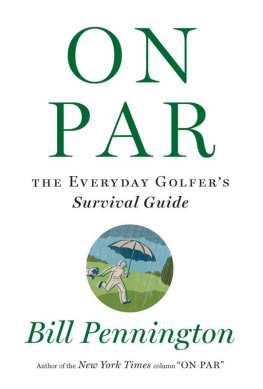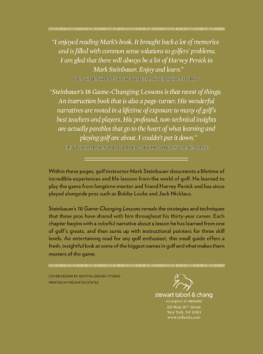Foreword by Gary Player
I am grateful to Danny Peary and Allen F. Richardson for asking me to contribute to their ambitious anthology. Their collection of articles, written by many of the greatest names in golf over the last 150 years and presented chronologically within the various chapters, confirms that golf instruction and golf history always have been intertwined. Similarly, golf instruction has been part of my history. I have taken instruction, given instruction, read instruction, and written instruction, all to my great benefit.
Undoubtedly, there is tremendous value in reading the essays in this large volume. Its my belief that reading is to the mind what exercise is to the body. While some golfers prefer visual stimulation in the way of video or photographic instruction, others learn more through reading. Learning the basic fundamentals and reading extensively about the game and how it is played is essential during the formative years of an aspiring golfer, and can clearly help an established golfer re-evaluate what he or she is doing. One must always be open-minded to learning more and changing, as I certainly was during my own career.
My earliest golf instruction was received from my father, who worked underground in the gold mines of South Africa. He was a good player and one day he was invited to play with the mining company executives. He asked me to join him, and I was immediately taken with the game. I was in my mid-teens when I took up golf, and my father taught me the basics. I played every chance I got. Over the years I have read most of the authors who appear in this book, but while growing up, I did not read instructional books at all. They simply were not available in South Africa at the time. However, Jock Verwey, the father of my girlfriend Vivienne (who is now my wife), was a golf coach in Johannesburg and became my instructor. Under his tutelage I began to develop into a pretty decent player and took the job as his assistant pro. The remarkable Ben Hogan and Sam Snead were the other two major influences on me as I set my sights on a professional career. I admired Hogan for his fundamentals and work ethic and Snead for his athleticism (and eventually his longevity).
As a club pro, the two things I tried to teach my pupils were patience and my now well-documented mantra, the harder I practice, the luckier I get. Unfortunately, its easier to get a camel through the eye of a needle than to get the average weekend golfer to practice. It is the hardest thing about being an instructor. However, I have never stopped telling aspiring golfers to practice, and that theme is common to all my books, including the one Im working on now.
The first book that really influenced how I played was not a golf book, but Norman Vincent Peales The Power of Positive Thinking , which definitely could be applied to the game and its instruction. Positive thinking in golf is a whole lot better than overthinking. I do believe too many young players, especially today, get paralysis of analysis. I also think many young players spend too much of their practice time trying to add distance to their drives. In some places it has been written that my philosophy has been to learn to hit the ball for distance, which always will stay with you, and then learn to golf the ball to score. But thats not my philosophy at all! Seventy percent of all shots are played from 100 yards in and so you must practice your short game with that in mind. That is my philosophyor, at least a major part of it.
Also, as someone who changed his grip and swing early on, I have taught and written that while there are right and wrong things to do in golf, it still must be left to the individual player to find what works or feels best for him or her. This is absolutely true. As long as you have learned the essential, basic funda- mentals, what your swing looks like is less important. One only has to look at Jack Nicklaus, Arnold Palmer, Lee Trevino, and me to see how different we look when swinging the club. However, our fundamentals are sound and thats what matters. As so many writers in this book stress: learn the fundamentals before moving on!
I believe that aspiring golfers who read this book will profit greatly from what the old masters wrote on various aspects of golf. Harry Vardon, Bobby Jones, Hogan, Snead and the others had to be, in many ways, more talented than todays young guns. Just consider the condition of the courses they played on and the equipment and ball they had to use. In fact, the views I expressed in the 1962 essay I wrote on escaping bunkers that is included in this volume, which might have been considered a breakthrough piece back then, have changed in some ways. Todays equipmentwedges with square grooves and more than 60 degrees of loft, for examplecoupled with the consistency of the sand in any given week on the Tour, have made bunker play much easier than it was 43 years ago. Unfortunately, a lot of touch, feel, and flare have been eliminated from sand play since I wrote The Blaster.
Modern equipment, the ball, and impeccably maintained golf courses are the biggest changes that have taken place in golf in the last 20 to 40 years. The theories on how to play the game havent evolved all that much; in the majority of cases, they have simply beenas this books editors point outre-examined and recycled using different language. As someone who is called the Worlds Most Traveled Athlete, I honestly believe that there has been absolutely nothing new with the golf swing since I began writing instruction. However, the changes in balls, clubs, and courses have resulted in a remarkable depth of talent on the Tour.
With so many players on the Tour having essentially the same skills, now more than ever its attitude, mental toughness, and the hunger to win that make the difference. I am pleased that this books editors also have included two golfers with whom Ive long been associated, Jack Nicklaus and Arnold Palmer, because there are no better models for young players who want to learn what it takes to win. When we competed as the so-called Big Three, I saw just how mentally tough they were.
Great Golf is a treasure trove of essays by golf champions, as well as the teachers of champions. If you want to become a complete golfer, physically and mentally, then you are sure to find what youre looking forjust begin on page one and keep reading. I am delighted that readers will find me in this book, as one of the individuals who has tried to play a part in the history of golf instruction.
Gary Player
5. Swing Components: The Devil Is in the Details
The Delayed Hit
1919 James M. Barnes
Long Jim Barnes stood 64 and towered over his more famous rivals, like Walter Hagen and Gene Sarazen, and consistently outhit them. Capitalizing on his victories in the first two PGA Championships, Barnes (who would later capture U.S. and British Opens) published the landmark book Picture Analysis of Golf Strokes . With full-page, stop-action photographs of his swing at various stagesand a minimum of explanatory textit was a How to Do It alternative to teaching manuals that featured long, descriptive, and often hyperbolic prose, and presaged todays instructional DVDs. Barnes book would be important if just for a photograph of his seemingly delicate wrists, freezing the moment before they snap the clubhead into the ball. This concrete image of the delayed-hit launched more theories than Helen did warshipsthe most common being: if golfers can maintain that power angle, they can increase power and distance.
Driver or Brassy
In starting the downward swing of the club the body begins to turn, and in unison with it the left wrist starts the clubhead. The left arm remains straight and pulls the club down simultaneously with the body turn. The right elbow comes in close to the body, still retaining the same bent position as at the top of the swing.
Next page
